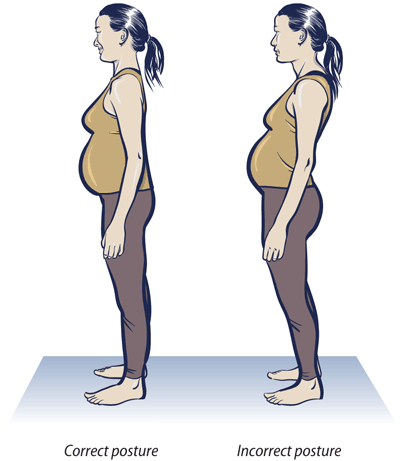Back
How Posture Affects Pelvic Floor Function During Pregnancy
By Dr. Christine Martirez PT, DPT on 8/2/2024

Pregnancy brings about significant changes to a woman’s body, including notable postural adjustments. These changes, while necessary for accommodating a growing baby, can place considerable stress on the pelvic floor. Understanding these postural shifts and their impact on the pelvic floor can help in managing and mitigating discomfort. In this blog post, we will explore the postural changes during pregnancy, how they affect pelvic floor function, and how pelvic floor physical therapy (PFPT) can help combat these changes.
Postural Changes During Pregnancy
During pregnancy, the body undergoes several postural adaptations to balance the shifting center of gravity and support the additional weight. Some of the most common changes include:
Increased Lumbar Lordosis:
As the abdomen grows, the lower back (lumbar spine) often curves more pronouncedly to accommodate the forward shift in the body’s center of gravity. This increased curve is known as lumbar lordosis.
Swayback Posture:
To compensate for the forward weight, many pregnant women develop a swayback posture, where the pelvis tilts forward, and the upper body leans back.
Glute Gripping:
To maintain balance and stability, some women may excessively contract their gluteal muscles, leading to what is known as glute gripping (and eventually leads to "mom butt"!)
Increased Thoracic Kyphosis:
The upper back (thoracic spine) may become more rounded, or kyphotic, due to changes in the center of gravity and the tendency to slouch forward as the breasts enlarge and the abdomen grows.
How Postural Changes Affect the Pelvic Floor
These postural adaptations, while functional, can place significant stress on the pelvic floor muscles:
Increased Lumbar Lordosis:
Impact:
The exaggerated curve in the lower back can cause the pelvic floor muscles to overstretch and weaken. This may lead to issues such as urinary incontinence and pelvic organ prolapse.
Swayback Posture:
Impact:
The forward tilt of the pelvis can alter the alignment of the pelvic floor muscles, leading to an imbalance in muscle tension and function. This can result in pelvic pain and discomfort.
Glute Gripping:
Impact:
Excessive contraction of the gluteal muscles can create undue pressure on the pelvic floor, leading to muscle tightness and pain. Over time, this can contribute to pelvic floor dysfunction and gluteal weakness.
Increased Thoracic Kyphosis:
Impact:
The rounded upper back can affect breathing mechanics and core stability, which in turn impacts the pelvic floor muscles. Poor posture in the upper body can lead to compensatory tension and weakness in the pelvic floor.
How Pelvic Floor Physical Therapy Can Help
Pelvic floor physical therapy offers targeted interventions to address the postural changes and their impact on the pelvic floor during pregnancy:
Comprehensive Assessment:
Evaluation:
A pelvic floor physical therapist will conduct a thorough assessment, including a review of medical history, symptoms, and a physical examination to identify areas of muscle tension and dysfunction.
Personalized Treatment Plan:
Manual Therapy:
Techniques such as myofascial release, trigger point therapy, and soft tissue mobilization can help reduce muscle tension and improve pelvic floor function.
Pelvic Floor Exercises:
Guided exercises to promote relaxation and strengthening of the pelvic floor muscles, improving their function and supporting overall pelvic health.
Core and Postural Exercises:
Exercises to strengthen the core and improve posture, helping to balance the demands placed on the pelvic floor muscles.
Education and Lifestyle Modifications:
Postural Training:
Education on maintaining proper posture and body mechanics to reduce strain on the pelvic floor muscles and improve overall alignment.
Breathing Techniques:
Instruction on proper breathing techniques to enhance core stability and reduce compensatory tension in the pelvic floor muscles.
Ergonomic Adjustments:
Advice on making lifestyle changes and incorporating supportive ergonomic adjustments to reduce strain on the body and pelvic floor.
The postural changes that occur during pregnancy, such as increased lumbar lordosis, swayback posture, glute gripping, and increased thoracic kyphosis, can significantly impact pelvic floor function. These adaptations, while necessary for accommodating a growing baby, can lead to discomfort and pelvic floor dysfunction. Pelvic floor physical therapy offers a comprehensive approach to addressing these issues, providing personalized treatment plans, postural training, and techniques to improve muscle function and overall pelvic health. If you are experiencing pelvic floor issues during pregnancy, consider consulting one of our pelvic floor physical therapists to develop a personalized plan that meets your unique needs and helps you achieve better overall well-being during and after pregnancy.
Read More:
How Chronic Pelvic Congestion in Men Contributes to Prostatitis By Shannon Strauch, PTA, STMT-1 on 12/11/2024 How lymphatic issues can cause symptoms of prostatitis Prostatitis and Tight Pelvic Floor Muscles: A Comprehensive Guide By Shannon Strauch, PTA, STMT-1 on 12/10/2024 How a tight pelvic floor can be the reason for prostatitis symptoms
Are you ready to live pain free?
Request An Appointment